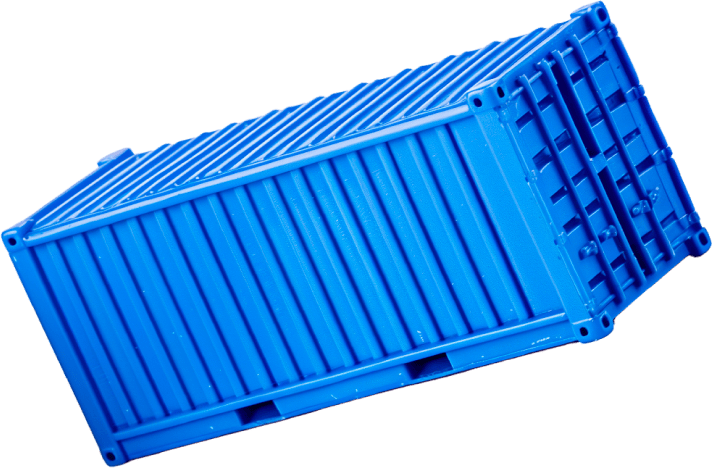Achieve Sustainable Logistics With End-to-End Planning

Kids love playing with toy trains and trucks, but logistics is serious business. If transport infrastructure is the circulatory system of the global economy, then logistics – and in particular, freight transportation – is the blood; the indispensable medium that carries goods around the world.

Yet it’s also one of our most polluting sectors: collectively, freight contributes 8% of GHG emissions worldwide¹. But of all modes of transport, rail is one of the most efficient, producing up to nine times fewer emissions, for a similar shipment, than road freight². This means it is set to play a key role in tomorrow’s freight landscape, with demand set to grow by 200% by 2050³.
However, rail faces a number of pressures – from emerging safety, labor, and ESG standards and regulations, to the impact of new technology, to economic and commercial pressures, to the ever-present risk of service disruption and cyber-attacks. For rail to play its part in a global sustainable transport mix, these problems need to be confronted.
Planning and Optimizing Logistics with Virtual Twins
One of the most effective ways of overcoming these challenges and achieving effective logistics and optimizing supply chain operations management is to leverage the power of virtual twins. They can provide a fully integrated view of planning and scheduling requirements, across all time horizons, in a way that also accounts for a dynamic regulatory landscape.
“Virtual twins create an end-to-end virtual environment where you can plan, visualize, manage, and optimize your freight operations – from network service, to crew and fleet, to rolling stock and yards maintenance, to terminals and yards – all in a fully connected environment.” says Lars Liebermann, Business Value Consultant Expert, Business Services Industry, at Dassault Systèmes.
For example, by deploying Dassault Systèmes’ 3DEXPERIENCE® solution, New Zealand’s KiwiRail was able to adopt a digital master rostering system that allowed parameters to be tweaked in real time and enable proactive staffing predictions – all while staying compliant with the latest labor regulations and guidelines.
“Better planning of our crew rosters will absolutely help us improve our service levels, because resource allocation in a business like ours is absolutely fundamental,” says Soren Low, National Service Delivery Manager Operations, KiwiRail.
Which digital technologies does your organization use?
Not using, but planning to within 12 months
Not using
Yes, but looking for advanced technology
Yes
Digitally Test and Validate Railway Operations
Virtual twins can also help when it comes to testing and validating rail operations. In particular, their powerful, end-to-end simulation capabilities have tremendous power to precisely understand how activities will function in reality, including day-to-day maintenance and operations running, while meeting quality and regulatory standards.
“With our capabilities you can model how different train configurations affect performance, to ensure optimal and efficient operations,” says Liebermann. “We can vary the number and types of locomotives or wagons coupled together, and learn how a train might behave at different speeds, or when it is empty or full, or when the track conditions vary.”
This can then be used to deliver more sustainable operations. For example, aerodynamic drag simulations can help operators pinpoint the configurations of carriages and locomotives that will deliver savings on both fuel costs and emissions. “It all contributes to a safer, more sustainable, and more reliable end-to-end operational service,” says Liebermann.
“Virtual twins create an end-to-end virtual environment where you can plan, visualize, manage, and optimize your freight operations – all in a fully connected environment.”
Now Playing: Bernardo on Disruptors Unleashed
In this podcast episode, Muthu Sivanantham, Rail & Logistics Industry Solutions Senior Manager at Dassault Systèmes, and 9-year-old Infrastructor Bernardo explore how to decarbonize freight and logistics with new approaches to energy management.

Maintaining and Managing the Fleet of the Future
Smart maintenance of rolling stock and fleet is another major pressure point for train operators – who must often contend with sub-optimal processes, siloed stakeholders. “Fleet maintenance success hinges on seamless communication and alignment between maintenance and operational managers to maximize efficiency.
By bringing data and stakeholders onto a single platform, complexity can be simplified, maintenance tasks streamlined, and costs and downtime reduced – all driving levels of service that are more economical for operators, and more reliable for end-users.
And by connecting all this to a holistic, end-to-end view of the network, operators can even identify solutions that at first glance seem counterintuitive. Lieberman gives an example: “Imagine multiple trains are having the same issue. That might be a problem with a particular make of train, but what if it’s not?”
Virtual twins let you look at the full picture, see trains in the context of their network, and spot patterns that you might otherwise miss. “Maybe it’s not a mechanical problem with the trains,” says Liebermann. “Maybe it’s a fuel issue; or perhaps track problems are causing the malfunction. Virtual twins let us spot those patterns and deploy targeted solutions.”
“If we want to deliver rail services that are ready for the future, we must develop the agility needed to operate competitively in a changing world,” says Liebermann. “Virtual twins are key to achieving that ambition.”

Insights on Sustainable Logistics
Sustainable logistics refers to the management of supply chain and transportation activities – from sea, road, air and rail – in ways that minimizes the environmental impact and promotes efficiency. For logistics operators, it involves strategies such as reducing emissions, optimizing fuel consumption, and using renewable energy sources to create a more eco-friendly and cost-effective logistics system. It also implies being more agile in daily activities; maintaining and extending the equipment, fleet and infrastructures’ lifespan; promoting intermodal modes of transportations (especially for the last-mile delivery); and also ensuring that the logistics workforce and all stakeholders are well trained.
The 4 A's of sustainable logistics are:
Awareness: Recognizing the importance of sustainability in logistics and understanding the environmental, social, and economic impacts of supply chain activities.
Assessment: Assessing human activities and optimizing them for sustainability with detailed environmental assessments and impacts of their activities across their entire value chain: from the ideation stage to the execution of a product or a service, from raw materials sourcing to packaging and transport, to manufacturing, to recovery, and finally to end-of-life. This sustainability-driven engineering approach allows logistics companies to continuously monitor, quantify, and assess the effectiveness of sustainability initiatives to ensure they meet set goals, or identify areas for improvement.
Alignment: Ensuring that all stakeholders, including logistics services providers, manufacturers, suppliers, customers, and internal teams, are not only aligned with sustainability goals and practices (for example by mutualizing resources); but that all stakeholders are truly concerned and well integrated in the process: by upskilling and training the workforce, in order to select the best sustainability options following instructions, products or transports constraints.
Action: Implementing concrete measures and strategies to reduce the environmental footprint of logistics operations, such as optimizing route sequence, making operations more agile, adapting cities to intermodal modes of transportation for the last-mile delivery, maintaining, improving, and extending the life duration of equipment, existing fleets of transportation, or replacing them with more renewable energy sources.
The principles of sustainable logistics involve strategies and practices aimed at reducing the environmental impact of logistics and supply chain operations while improving efficiency.
Here are key principles:
Reduction of Emissions: Implementing measures to decrease greenhouse gas emissions from transportation and logistics activities. This can include using cleaner fuels, optimizing routes, and adopting fuel-efficient vehicles.
Energy Efficiency: Enhancing energy efficiency in logistics operations or improving the emissions associated with the distribution facilities which can be eliminated via clean energy-powered electricity, solar systems, and water recycling systems.
Resource Optimization: First by monitoring transport methods in real-time with best alternatives identification, and risk of empty mileages reduction by loading vehicles to optimum capacity, which is both environmental and profit-friendly. Secondly, the efficient use of resources through better planning which avoids long breaks or processing gaps in between the logistics operations – resulting in eliminating the waste, transport, and labor costs, and, of course, carbon emissions, as well as scheduling, and utilization of logistics assets, which helps in minimizing waste and reducing costs.
Reverse logistics: Specifically applies to industries with large amounts of products returned by the customers that must be recovered, recycled or re-circulated – such as fast fashion, for example. Reverse logistics can help to reduce the impact of waste on the environment.
Logistics Infrastructure retrofitting: Applies to the modernization or expansion of existing facilities and equipment like logistics fleet and warehouses.
Sustainable Packaging: Integrating more circular practices through a company packaging strategy with lifecycle assessments, carbon emissions analysis, compatibility with other materials, weight and performance, optimizing transport loads through minimal packaging waste.
Collaboration and Partnerships: Working with partners, suppliers, and stakeholders to create a sustainable logistics network that shares resources and reduces overall environmental impact.
Technology and Innovation: Leveraging advanced technologies for tracking like IoT, AI, but also sensors and data analytics to monitor & collect data on speed, fuel consumption & breaking behaviour of drivers, leading to enhancing supply chain visibility, predicting demand, and optimizing logistics processes for sustainability.
Lifecycle Assessment: Conducting lifecycle assessments to understand and mitigate the environmental impact of logistics activities from raw materials sourcing, to packaging and transport, to manufacturing, to recovery and end-of-life.
Use of Renewable Energy: Incorporating renewable energy sources such as solar, wind, and biofuels into logistics operations – including fleet, equipment and warehouses, to reduce reliance on fossil fuels.
Regulatory Compliance: Adhering to environmental regulations and standards set by governments and international bodies to ensure sustainable logistics practices, while ensuring the logistics network continuity among borders and countries.
Continuous Improvement: Regularly monitoring, evaluating, and improving logistics operations to enhance sustainability and adapt to new challenges and opportunities.
The circular economy is not transforming the logistics sector today, but rather it is accelerating a trend that’s already in place. Logistics operators are applying most of these fundamentals in their strategies to improve ways of operating and reduce costs.
From design to operations, companies can re-adapt their operations to have less impact overall the entire supply chain journey.
Most of the topics need validation from the company for which the logistics provider is operating. Some initiatives may require investments that should be taking taken over by customers.
All information is not always available to make the best decisions. Data received from customers are not necessarily accurate, which reduces the opportunity to use them for parcel selection (SKU dimensions, logistics parameters).
Being able to adapt SLAs (Service Levels) during peak periods could help smoothing streamline large volumes and limit the need to increase capacity.
Upskilling workforce: For example, in a warehouse: Training of people to ensure packers can select the best parcel depending on customers' instructions and products or transport constraints.
Environmental Benefits:
Reduced emissions and pollution through cleaner fuels and optimized routes.
Conservation of resources and waste reduction with sustainable practices.
Economic Benefits:
Cost savings from energy efficiency and waste minimization.
Enhanced efficiency and long-term viability with optimized supply chain processes.
Social Benefits:
Improved health and safety standards for employees.
Positive community impact and stronger stakeholder relationships.
Sustainable transportation and logistics refer to the practices and strategies used to minimize environmental impact within the logistics and transportation sectors. This involves reducing carbon emissions, optimizing fuel efficiency, and integrating renewable energy sources. These practices are vital for the future as they help combat climate change, reduce resource consumption, and support the transition to a more sustainable economy.



